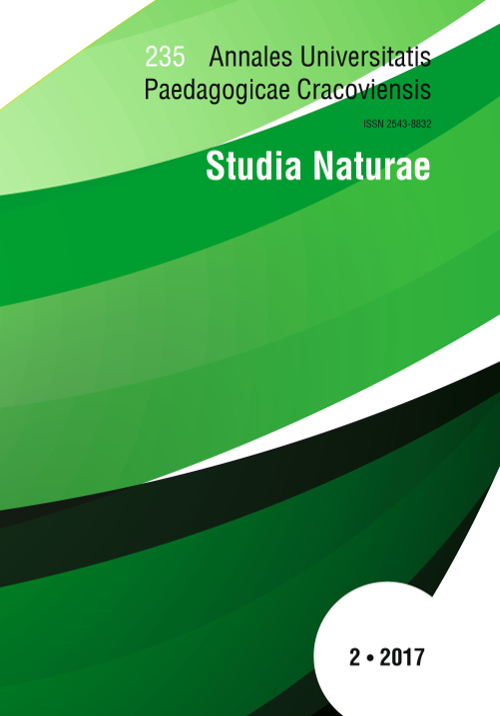The impact of temperature and photosynthetically active radiation on the growth and pigments concentration in Baltic picocyanobacterium Synechococcus sp.
DOI:
https://doi.org/10.24917/25438832.2.4Keywords:
picocyanobacteria, growth, PAR, photosynthetic pigments, temperatureAbstract
The experiments on three Baltic picocyanobacterial strains of Synechococcus (BA-120 - red strain, BA-124 - green strain and BA-132 - brown strain) were conducted at four scalar irradiances in Photosynthetically Active Radiation (PAR) and four temperature levels. The main aim of this work was to estimate the effect of environmental conditions (temperature and PAR) on cell concentration and photosynthetic pigments (Chlorophyll a - Chl a and Carotenoids - Car) contents. The ranges of PAR and temperatures were 10, 100, 190, 280 μmol m-2 s-1 and 10, 15, 20, 25ºC, respectively. The experiment was carried in a medium of salinity of 8. The number of Synechococcus sp. cells was determined using a BD Accuri™ C6 flow cytometer. The pigments contents were determined by a spectrophotometric method. In this work, it was found that elevated intensity and temperature have, on average, a positive effect on cell concentration for Synechococcus sp. The highest cells concentrations were noted at the highest PAR (280 µmol m-2 s-1) and the highest T (25ºC) for green and brown strains (BA-124 and BA-132, respectively) and at 190 µmol m-2 s-1 and 25ºC for red strain (BA-120). Comparing the strains at each PAR level and temperature, the highest cell concentration was noted in green strain (36·106 cell ml-1), while the lowest was observed in red strain (8·106 cell ml-1). In general, in the two strains of Synechococcus (BA-120 and BA-132), the highest Car and Chl a contents were observed at the lowest light intensity and the highest temperature. On the other hand, Car and Chl a maximum content in BA-124 were noted at the lowest light and temperature. The experiments on Synechococcus strains demonstrated their high capacity to acclimate to a wide range of PAR and temperature levels. The three strains of Synechococcus showed adaptation capabilities, since they were able to change the composition of their photosynthetic pigments to use light quantity better and to protect the cells from the unfavourable effect of elevated light and temperature.
Downloads
Metrics
References
Agawin, N.S., Duarte, C.M., Agusti, S. (1998). Growth and abundance of Synechococcus sp. in a Mediterranean Bay: seasonality and relationship with temperature. Marine Ecology Progress Series, 170, 45–53.
Antia, N.J. (1976). Effects of temperature on the darkness survival of marine microplanktonic algae. Microbial Ecology, 3(1), 41–54.
Callieri, C., Moro, S., Caravati, E., Crosbie, N.D., Weisse, T. (2005). Stain-specific photosynthetic response of freshwater picocyanobacteria. Verhandlungen des Internationalen Verein Limnologie, 29, 777–782.
Callieri, C. (2010). Single cells and microcolonies of freshwater picocyanobacteria: a common ecology. Journal of Limnology, 69(2), 257–277. https://doi.org/10.4081/jlimnol.2010.257
Defew, E.C., Perkins, R.G., Paterson, D.M. (2004). The influence of light and temperature interactions on a natural estuarine microphytobenthic assemblage. Biofilms, 1, 21–30. https://doi.org/10.1017/S1479050503001054
Flombaum, P., Gallegos, J.L., Gordillo, R.A., Rincón, J., Zabala, L.L., Jiao, N., Vera, C.S. (2013). Present and future global distributions of the marine Cyanobacteria Prochlorococcus and Synechococcus. Proceedings of the National Academy of Sciences, 110(24), 9824–9829. https://doi.org/10.1073/pnas.1307701110
Guillard, R.R.L. (1975). Culture of phytoplankton for feeding marine invertebrates. In: W.L. Smith, M.H. Chanley (eds.), Culture of Marine Invertebrate Animals. Plenum Press, New York, USA, 26–60. https://doi.org/10.1007/978-1-4615-8714-9
Ibelings, B.W. (1996). Changes in photosynthesis in response to combined irradiance and temperature stress in cyanobacterial surface waterblooms. Journal of Phycology, 32, 549–557. https://doi.org/10.1111/j.0022-3646.1996.00549.x
Jasser, I. (2006). The relationship between autotrophic picoplankton (APP) – the smallest autotrophic component of food web and the trophic status and depth of lakes. Ecohydrology and Hydrobiology, 6(1–4), 69–77. https://doi.org/10.1016/S1642-3593(06)70128-8
Jasser, I., Arvola, L. (2003). Potential effects of abiotic factors on the abundance of autotrophic picoplankton in four boreal lakes. Journal of Plankton Research, 25(8), 873–883. https://doi.org/10.1093/plankt/25.8.873
Jodłowska, S., Śliwińska, S. (2014). Effects of light intensity and temperature on the photosynthetic irradiance response curves and chlorophyll fluorescence in three picocyanobacterial strains of Synechococcus. Photosynthetica, 52(2), 223–232. https://doi.org/10.1007/s11099-014-0024-y
Kana, T.M., Glibert, P.M. (1987a). Effect of irradiances up to 2000 μmol E·m-2·s-1 on marine Synechococcus WH7803-I. Growth, pigmentation, and cell composition. Deep-sea Research, 34(4), 479–495. https://doi.org/10.1016/0198-0149(87)90001-X
Kana, T.M., Glibert, P.M. (1987b). Effect of irradiances up to 2000 μmol E·m-2·s-1 on marine Synechococcus WH7803-II. Photosynthetic responses and mechanisms. Deep-sea research, 34(4), 497–516. https://doi.org/10.1016/0198-0149(87)90002-1
Latała, A., Jodłowska, S., Pniewski, F. (2006). Culture Collection of Baltic Algae (CCBA) and characteristic of some strains by factorial experiment approach. Algological Studies, 122(1), 137–154. https://doi.org/10.1127/1864-1318/2006/0122-0137
Marie, D., Simon, N., Vaulot, D. (2005). Phytoplankton cell counting by flow cytometry. Algal Culturing Techniques, 1, 253–267.
Mazur-Marzec, H., Sutryk, K., Kobos, J., Hebel, A., Hohlfeld, N., Błaszczyk, A., Toruńska, A., Kaczkowska, M.J., Łysiak-Pastuszak, E., Kraśniewski W., Jasser, I. (2013). Occurrence of cyanobacteria and cyanotoxin in the Southern Baltic Proper. Filamentous cyanobacteria versus single-celled picocyanobacteria. Hydrobiologia, 701, 235–252. https://doi.org/10.1007/s10750-012-1278-7
Millie, D.F., Ingram, D.A., Dionigi, C.P. (1990). Pigment and photosynthetic responses of Oscillatoria agardhii (Cyanophyta) to photon flux density and spectral quality. Journal of Phycology, 26, 660–666. https://doi.org/10.1111/j.0022-3646.1990.00660.x
Prézelin, B.B. (1981). Light reactions in photosynthesis. In: T. Platt, (ed.), Physiological Bases of phytoplankton Ecology. Canadian Bulletin of Fisheries and Aquatic Sciences, no. 210, Ottawa.
Richardson, T.L., Jackson, G.A. (2007). Small phytoplankton and carbon export from the surface ocean. Science, 315(5813), 838–840. https://doi.org/10.1126/science.1133471
Six, C., Finkel, Z.V., Irwin, A.J., Campbell, D.A. (2007). Light variability illuminates niche-partitioning among marine picocyanobacteria. PLoS One, 2(12), e1341. https://doi.org/10.1371/journal.pone.0001341
Stal, L.J., Walsby, A.E. (2000). Photosynthesis and nitrogen fixation in a cyanobacterial bloom in the Baltic Sea. European Journal of Phycology, 35, 97–108. https://doi.org/10.1080/09670260010001735681
Stal, L.J., Albertano, P., Bergman, B., Bröckel, K., Gallon, J.R., Hayes, P.K., Sivonen, K., Walsby, A.E. (2003). BASIC: Baltic Sea cyanobacteria. An investigation of the structure and dynamics of water blooms of cyanobacteria in the Baltic Sea – responses to a changing environment. Continental Shelf Research, 23, 1695–1714. https://doi.org/10.1016/j.csr.2003.06.001
Stockner, J.G. (1988). Phototrophic picoplankton: an overview from marine and freshwater ecosystems. Limnology and Oceanography, 33, 765–775. https://doi.org/10.4319/lo.1988.33.4part2.0765
Strickland, I.D.H., Parsons, T.R. (1972). A practical handbook of seawater analysis. Journal of the Fisheries Research Board of Canada, 167, 1–310.

